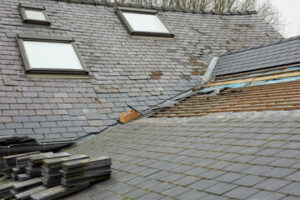Roof Repair Antioch TN is a big decision that impacts your home’s structure and long-term value. Understanding your roofing options gives you confidence in choosing the right option based on your roof’s condition, age, and maintenance history.

For example, if your roof has water stains or damp spots in the attic, a partial repair may be sufficient. Localized damage such as a missing shingle or a small leak can be repaired quickly and inexpensively.
The cost of Roof Repair varies depending on the type and severity of damage. Minor leaks can cost as little as $150, while more serious problems can escalate to a significant expense. In addition, the cost of materials and labor also plays a role in the total cost. Local labor rates, materials availability, and regional regulations or permit fees can increase or decrease the overall cost of the project.
Homeowners can often minimize the cost of Roof Repair by addressing issues as they arise. Regular maintenance and inspections can help identify potential problems, such as leaking shingles or structural damage, before they worsen. This preventive approach can save homeowners significant costs in the long run, especially when compared to a full replacement.
In addition to the potential cost savings, Roof Repair can also add value to a property. New roofing materials can improve the curb appeal of a home, boost energy-efficiency, and even increase resale value. Furthermore, buyers are increasingly expecting new roofs when they are ready to purchase a home. Therefore, replacing an older roof with resilient materials can future-proof a property for additional harsh weather conditions and reduce the time it takes to sell.
Whether or not a homeowner chooses to undertake the repairs themselves depends on their budget and level of expertise. However, it is important to note that a DIY roofing project can increase the total cost of the project due to the need for tools and equipment, as well as the time required for completion.
It is essential to hire a professional for more complex roof repairs and replacements, as they have the experience and knowledge to ensure a quality job. Professionals can also provide a warranty on their work, which can further protect the homeowner’s investment.
The longevity of a Roof Repair project depends on the material used and the extent of the damage. For example, asphalt shingle repairs are fairly durable and can last up to 15 years, whereas wood shakes have a much shorter lifespan and are more susceptible to rot and insect damage.
Time
The bedrock of any long-term home renovation project is investing in a robust and resilient roof structure. This safeguards your house from the harsh Wellington climate and protects the investment in your home’s interior. Neglecting regular roof repair can lead to costly damage and serious health risks. Addressing issues like missing or cracked shingles, water spots and leaks quickly extends the lifespan of your roof and prevents damage to interiors, furniture and possessions.
It’s important to prioritise critical upgrades and work with a trusted contractor to ensure they are executed correctly. A well-functioning roof will provide years of protection and add value to your property. Keeping up with routine repairs, leveraging financial incentives and making smart home improvement decisions will unlock long-term savings that can be invested in the more flashy upgrades you’ve had your eye on.
How long it takes to complete a Roof Repair is largely dependent on the scope of work involved and the type of roofing material. Generally, minor repairs, like replacing damaged shingles or fixing chimney flashing, are relatively quick fixes that take one to five hours. However, more extensive work like repairing leaks or improving ventilation can require several days to complete.
A sagging roof, for example, may require more extensive structural work, including reinforcing timbers and re-tiling. This can take up to a month and is more costly than a simple shingle repair.
If the extent of the damage is not immediately clear, the first step is a comprehensive inspection. This involves checking the inside of your home, including ceilings and walls, as well as outside the property for damage to shingles, gutters, chimneys, vents and the roof itself. Once the damage has been assessed, the most cost-effective option is usually to repair only those areas that are leaking or showing obvious signs of wear and tear.
Pipe boots, another common repair, seal the gap between the roof surface and penetrations such as chimneys. They can be made from plastic, metal or a rubber composite but often become brittle due to sun exposure and crack, allowing water to seep down the pipes and into your home. A new, more efficient pipe boot typically takes just an hour or two to replace and can protect your home for years to come.
Safety
The roof is an essential part of a home, providing protection from the elements and contributing to the overall structural integrity of the building. Over time, a damaged or worn-out roof can cause structural problems, including leaks and sagging, which may affect the safety of the house’s occupants. Regular roof maintenance is necessary to prevent damage and extend the life of the structure.
Performing roof repairs is not an easy task, and can be dangerous if the proper precautions are not taken. Stairways and ladders must be secured, and workers should wear protective gear to avoid injuries from falling debris. It is also important to keep in mind that a faulty roof can lead to serious health issues, such as mold growth and respiratory problems. In addition, water damage from a faulty roof can lead to electrical problems and fires.
A professional roofing contractor can help you choose the best roof repair for your needs and budget. They will inspect the condition of your existing roof, determine its age and type, and assess any potential repairs. Then, they will recommend the appropriate roofing material and installation techniques. In some cases, a complete roof replacement may be required, while in other cases, repairing specific areas of the roof is sufficient.
Leaks, cracks, or deteriorating sealants are common roof problems that can cause significant damage to the interior of a building. To correct these problems, a roofing contractor will repair the damaged areas and apply new sealants or flashing to prevent water infiltration. They will also replace any broken or missing shingles.
Other roof repair services include installing or repairing vents, adding insulation, and improving airflow to prevent moisture problems and enhance energy efficiency. They will also address any structural concerns, such as sagging, which could indicate that the roof is at risk of collapse.
Working on a roof can be hazardous due to the height and slippery surface. To minimize these risks, homeowners should invest in the right safety equipment, such as non-slip shoes and a safety harness. They should also clear the area of the roof of any debris, tools, or materials that might cause a tripping hazard or obstruct the work zone.
Preparation
Whether it’s a small patch job or a full roof replacement, any repair work requires thorough preparation. This includes assessing the extent of the damage, preparing tools and materials, and preparing for weather conditions. For example, it’s crucial to choose a dry day for repairs so that moisture doesn’t get trapped underneath the new material. Similarly, it’s important to make sure that the roof is completely clean to ensure proper adhesion of the new materials.
The preparation stage also involves ensuring that the roof is safe to work on. This includes using a ladder that’s sturdy enough to support the weight of workers and ensuring that all necessary safety precautions are taken. In addition, it’s essential to use a fall protection system or a harness and wear gloves to protect against any potential hazards.
While performing the repairs, it’s important to keep a continuous line of sight. This is because it’s easy for structures, equipment and supplies to impede your view and cause you to accidentally step over the edge of the roof. This can lead to serious injuries. It’s also important to be aware of any hazardous materials that are on the roof, including asbestos and lead-based paint, which pose health risks if disturbed or inhaled.
In addition to repairing leaks, roof repairs can also include replacing missing or damaged shingles. This can prevent water infiltration, which can damage ceilings, walls, and personal belongings. It can also reduce a home’s energy efficiency and cause mold and mildew issues in the interior spaces.
Another common repair is addressing deteriorating flashing. This is a thin strip of metal that’s installed around parts of the roof, such as chimneys, vent pipes, and skylights. Over time, flashing can deteriorate or become displaced, which can cause leaks and damage to the underlayment. Repairing or replacing faulty flashing is an important part of preventing water infiltration and reducing energy costs.
In addition to repairing leaks and replacing shingles, roofing professionals can also install additional drainage points or slightly modify the slope of the roof. This can help improve water runoff and reduce the risk of ponding, which can lead to leaks and structural damage.
